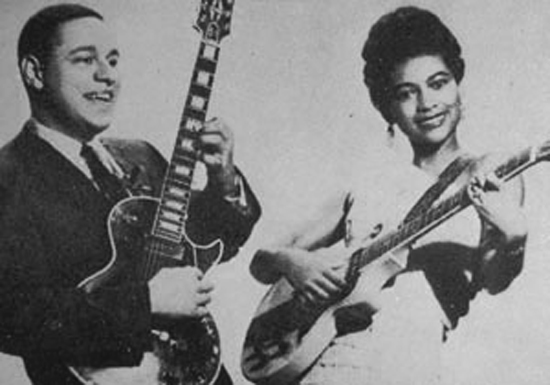1979 – The Birth Of Commercial Hip Hop?

It’s not unusual for someone to say to me in conversation “yeah, a lot of old hip hop was great, but it’s all so commercial these days”. It’s an understandable thing to say, but the truth is I’d rather tell the person why I think they’re wrong than politely nod and agree (which, being the easy option, I tend to do). I say that not so much because there is a wealth of creative and forward thinking hip hop still being released (although that is true), but more importantly because commercialism has been a fairly major aspect of hip hop more or less since the genre’s birth.
It’s not insignificant that hip hop’s first major hit, 1979’s “Rapper’s Delight” was performed by a group that was not, as some may have assumed at the time, a fixture of New York’s hip hop underground, but a group brought together by Sugarhill Records mastermind, Sylvia Robinson.
Sylvia Robinson (pictured above alongside Mickey Baker performing as 50s / 60s RnB duo “Mickey and Sylvia”), had experienced some success as a recording artist releasing the Bo Diddley penned hit “Love Is Strange” in 1957. Sylvia made her first moves into the publishing side of music in the late 60s, forming “All Platinum Records” with husband Joe Robinson in 1968.
Sylvia went on to have further success as a solo artist into the 70s, releasing the 1973 proto-disco cut “Pillow Talk”, a track originally written for but rejected by Al Green. With experience as both artist and publisher and a feel for what constituted a commercially viable club record, Sylvia was well placed to cash in on hip hop’s growing popularity and form the group that would have hip hop’s first hit, The Sugarhill Gang.
The rap phenomenon was quick to be adopted by mainstream culture with successful pop acts such as Blondie incorporating rap into their music as early as 1981. Throughout the 80s respected underground acts flirted with the more commercially accessible aspects of hip hop; LL Cool J attracted criticism from many of his peers following the release of his 1987 ‘love-rap’ hit ‘I Need Love’ although many artists included similarly styled tracks on their albums in subsequent years. Other artists looked to the club for commercial success with the hip hop / house music hybrid of ‘hip house’ starting to make an appearance on albums from credible artists including EPMDand Craig G in the late 80s.
Over the years that followed, commercialism in hip hop has taken on a number of different guises. In the late 80s and early 90s ‘pop rap’ acts such as Vanilla Ice and MC Hammer would appear in stark contrast to the genre’s more hardcore proponents, who largely dismissed their output as not truly constituting hip hop at all. It would be easy to assume that commercial hip hop of the late 80s and early 90s was limited to that with a pop gloss, but there was another side to the coin. Revered underground acts of the era including NWA and Ice T clearly saw that the controversy caused by subversive political opinions and explicit depictions of violence in their lyrics could be exploited commercially. Ice-T’s “Cop Killer” is arguably the most overt example of use of negative press to raise profile and ultimately sell records that the genre has ever seen. Miami’s 2 Live Crew used graphic sexual imagery to similar effect. Ironically, the ‘Parental Advisory’ stickers introduced by the U.S. in an attempt to partially censor such content became worn on album sleeves almost as badges of honour and authenticity, and arguably helped boost sales of those releases for which the censors deemed the sticker necessary.
In the mid to late 90s, commercial hip hop took on a new face when a host of artists saw the potential for mainstream success with a hybrid of hip hop and the emerging RnB sound of the day. Building on the foundations laid by the ‘New Jack Swing’ sound of the early 90s, pioneered by producer Teddy Riley, Bad Boy Records producer Sean Puffy Combs played no small part in shaping the RnB hip hop crossover sound of the mid to late 90s. It’s not without irony that some of this emerging cross over style’s most important records were recorded by one of ‘real’ hip hop’s most revered stars, Notorious B.I.G.
Beyond the year 2000, hip hop has become well and truly established in the mainstream with a very obvious divide between musical stylings of the multi-platinum selling mainstream artists and the independent underground. Many would say that the commercial material of this era is characterised by the focus of the lyrics on wealth and success, but this is nothing new: the pursuit of wealth, cars and of course ostentatious gold jewellery were all prominent themes in many classics from the 80s underground. The defining characteristic of commercial hip hop from the last decade has been, perhaps more than anything else, the production style, with a well produced studio sound and glossy finish being the staple of many mainstream hits that might otherwise have been relatively underground records, artists such as 50 Cent and Dr Dre being obvious examples.
As we enter a new decade, hip hop continues to splinter in countless directions with new sub-genres of both commercial and undergound sounds emerging all the time. Many artists have enjoyed commercial success with uncompromising albums, Common and Cee-Lo being good examples. Many artists pursuing a traditionally commercial sound remain unsigned. One thing is certain though; commercialism remains somewhere in the mix.
If there were ever a time when it could be said that hip hop was created entirely without commercial concern, then those days were before the release of the first rap record in 1979, but that’s not something to lament. Were it not for Sylvia’s eye for a commercial opportunity, hip hop (commercial or otherwise) might never have lived beyond the streets of New York.